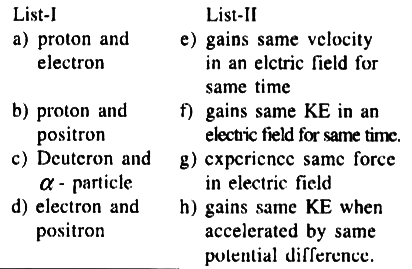List-I List-II
a) interference e) transverse nature of light
b) diffraction f) unequal absorption of ordinary and extraordinary ray
c) polarization g) bands of equal width
d) dichroism h) bands of unequal width
A−F,B−G,C−H,D−E
A−H,B−G,C−F,D−E
A−E,B−F,C−G,D−H
A−G,B−H,C−E,D−F
The correct Answer is:D
Topper's Solved these Questions
- WAVES OPTICSBOOK - AAKASH SERIESCHAPTER - WAVES OPTICSEXERCISE - EXERCISE -IA (ASCENDING AND DSCENDING ORDER TYPE QUESTIONS)
6 Videos
- WAVES OPTICSBOOK - AAKASH SERIESCHAPTER - WAVES OPTICSEXERCISE - EXERCISE -IB (ASSERTION AND REASON)
68 Videos
- WAVES OPTICSBOOK - AAKASH SERIESCHAPTER - WAVES OPTICSEXERCISE - EXERCISE -IA (MORE THAN ONE OPTION)
15 Videos
- WAVESBOOK - AAKASH SERIESCHAPTER - WAVESEXERCISE - EXERCISE-III (Doppler effect :)
15 Videos
Similar Questions
List-I List-II
a) Einstein e) velocity of light
b) Huygen f) diffraction of light
c) Focault g) wave nature of light
d) Fresnel h) particle nature of light
View SolutionWhich of the following phenomenon proves the transverse nature of electromagnetic waves? (A) polarization (B) interference (C) diffraction (D) reflection
View Solution
Knowledge Check
Match the following
List - I List - II a) Silver lining of mountains e) polarization by refraction b) Rectilinear propagation light f) transverse nature of light c) Polarizationg) diffraction d) Pile of platesh) ray opticAa−h,b−g,c−f,d−eBa−g,b−h,c−e,d−fCa−f,b−h,c−h,d−eDa−g,b−h,c−f,d−eMatch the following
List - I List - II a) Interferencee) Thamos young b) Polarisation by f) Bartholinus reflection c) Diffraction g) Grimaldi d) Polarisation by h) Malus refractionAa−e,b−g,c−f,d−hBa−h,b−f,c−g,d−eCa−e,b−h,c−g,d−fDa−h,b−g,c−f,d−e
List-I List-II
a) Fresnel's diffraction e) Bright band
b) Fraunhofer's diffraction f) Source and screen are at finite distance
c) In interference phase difference is even multiple of π g) Dark band
d) In interference phase difference is odd multiple of π h) Source and screen are at infinite distance
View SolutionWhich of the following properties show that light is a transverse wave? a) Reflection b) Interference c) Diffraction d) Polarization
View Solution(a) Derive the relation a sinθ=λ for the first minimum of the diffraction pattern produced due to a single slit of width ‘a’ using light of wavelengthλ.
(b) State with reason, how the linear width of central maximum will be affected if
(i) monochromatic yellow light is replaced with red light, and
(ii) distance between the slit and the screen is increased.
(c) Using the monochromatic light of same wavelength in the experimental set-up of the diffraction pattern as well as in the interference pattern where the slit separation is 1 mm, 10 interference fringes are found to be within the central maximum of the diffraction pattern. Determine the width of the single slit, if the screen is kept at the same distance from the slit in the two cases.
View SolutionList-I List-II
a) interference e) transverse nature of light
b) diffraction f) unequal absorption of ordinary and extraordinary ray
c) polarization g) bands of equal width
d) dichroism h) bands of unequal width
View SolutionMatch List-I with List-II

View Solution(a) Derive the relation asinθ=λ for the first minimum of the diffraction pattern produced due to a single-slit of width 'a' using light of wavelength λ.
(b) State with reason, how the linear width of central maximum will be affected if (i) monochromatic yellow light is replaced with red light, and (ii) distance between the slit and the screen is increased.
(c) using the monochromatic light of same wavelength in the experimental set-up of the diffraction pattern as well as in the interference pattern where the slit separation is 1mm, 10 interference fringes are found to be within the central maximum of the diffraction pattern. determine the width of the single-slit, if the screen is kept at the same distance from the slit in the two cases.
View Solution
